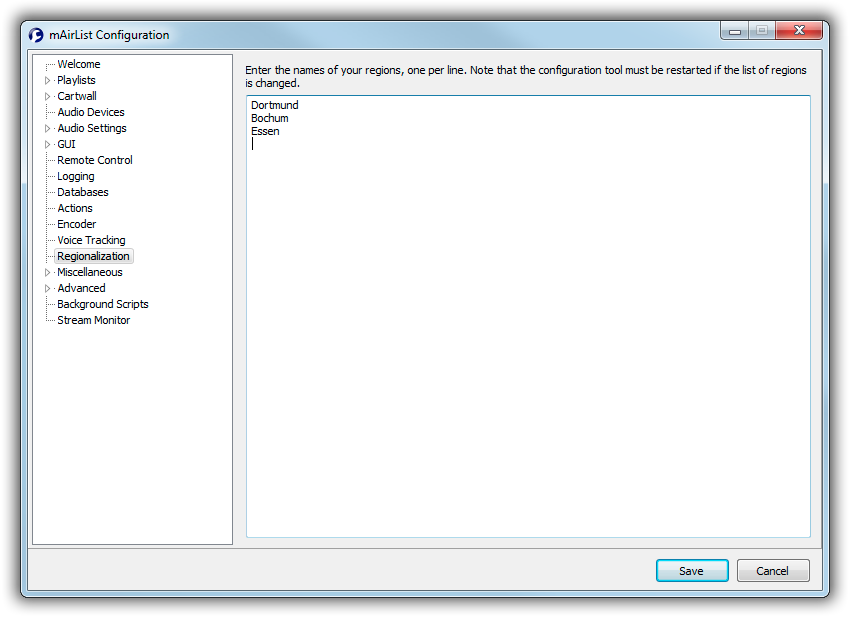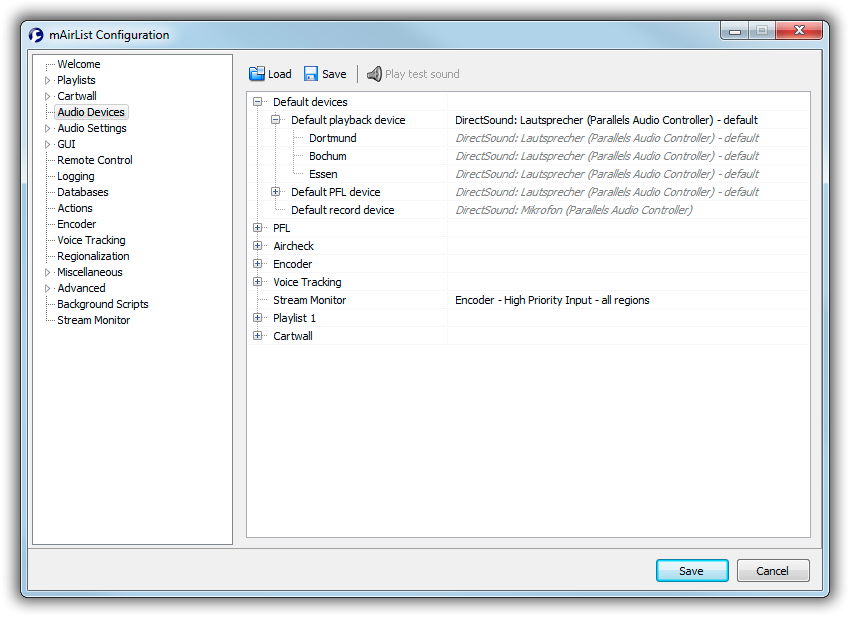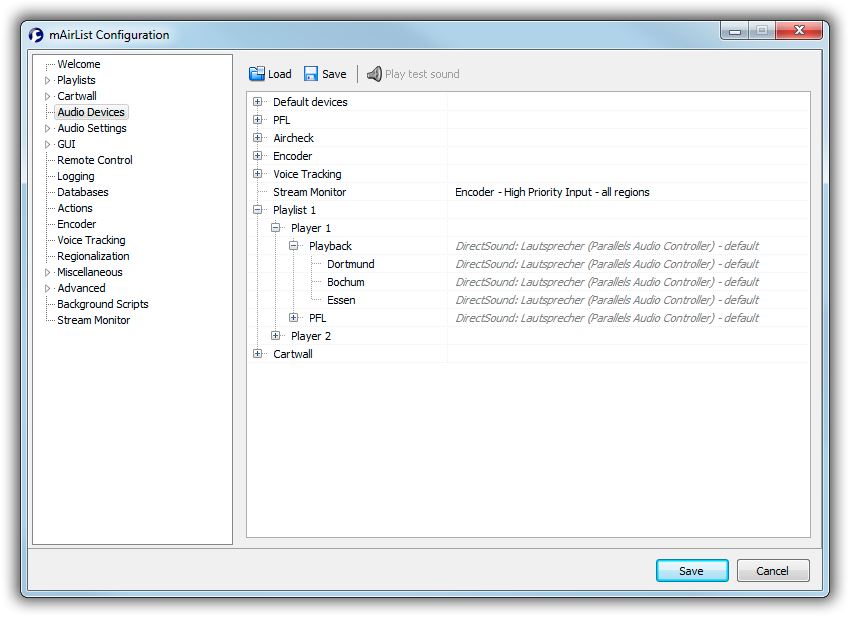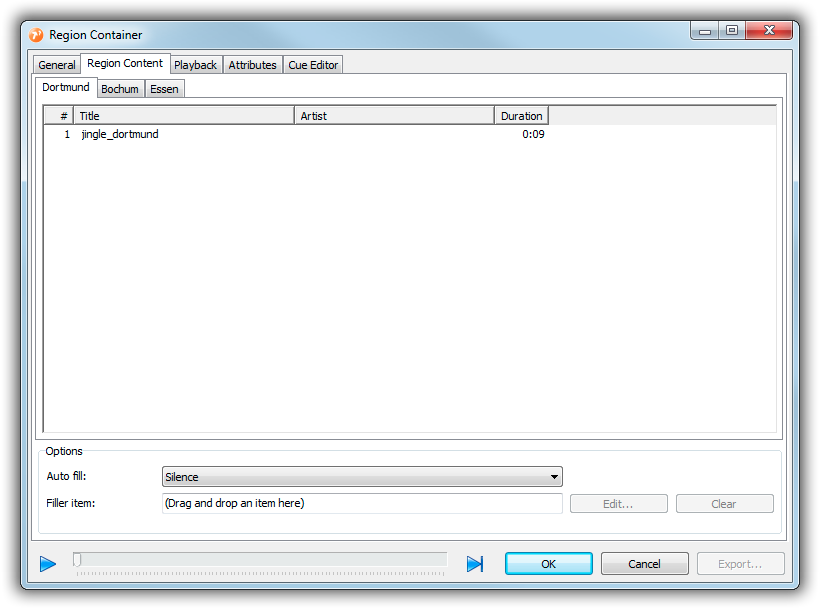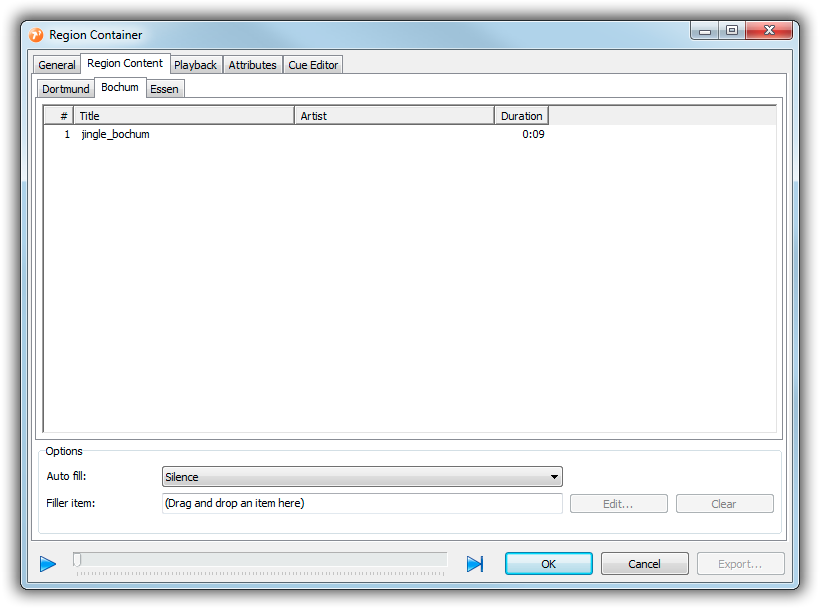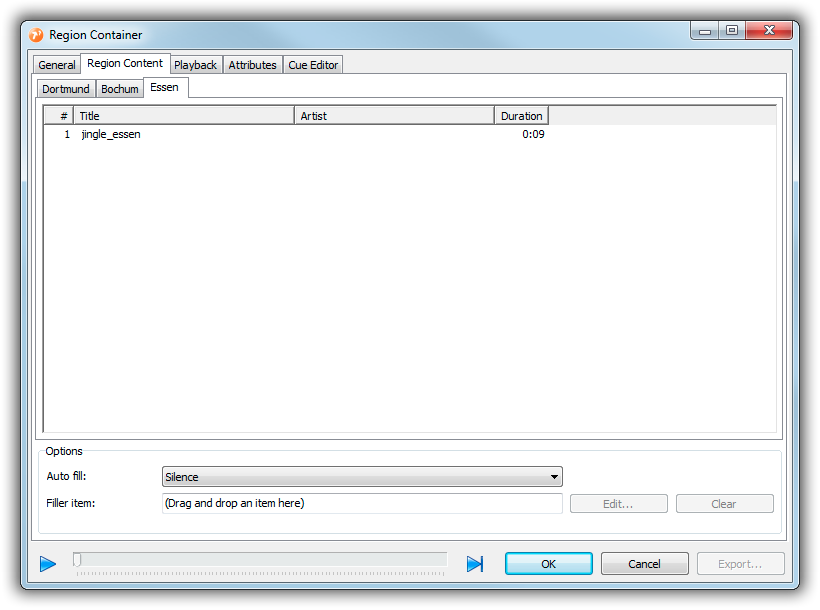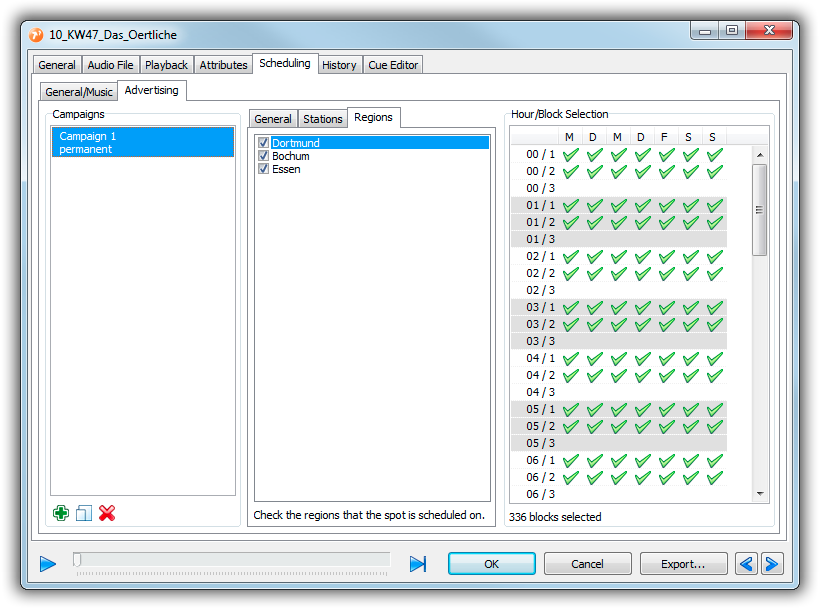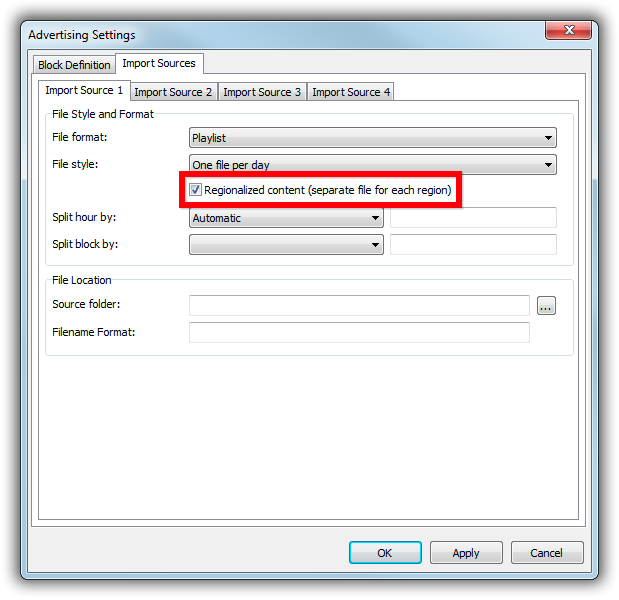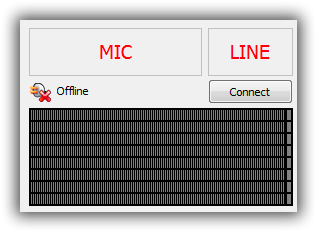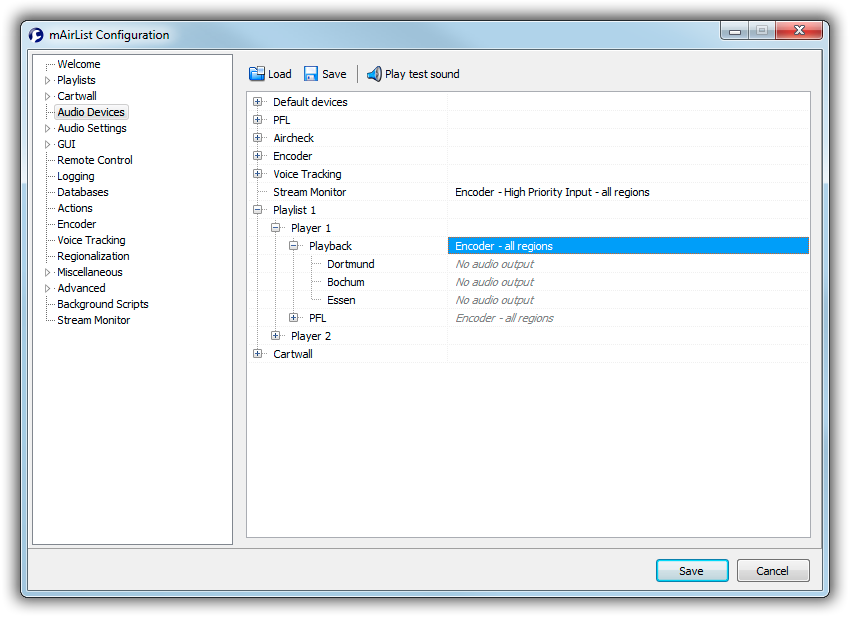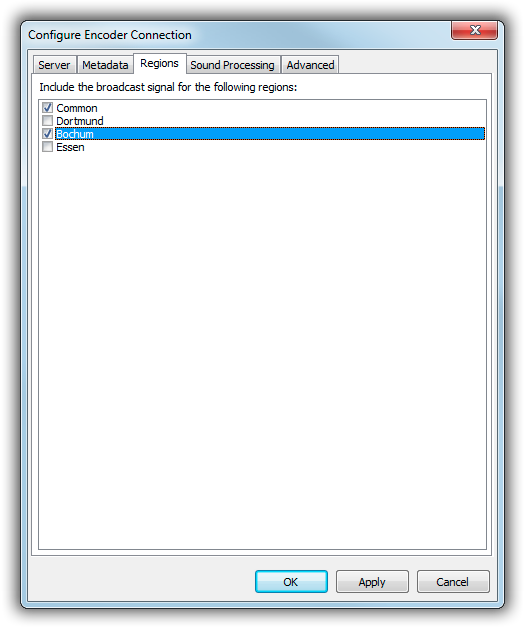Table of Contents
Region Playout
Region playout (or “regionalization”) is mAirList's ability to route audio content from special playlist items – Region Containers – to distict sound cards, so you can create broadcasts that are essentially the same (music), but use “regionalized” content at special times (jingles, news, advertising).
For example, when you have three FM regions, and all of them should have their own set of jingles, or different advertising, you can use Region Containers to the schedule the jingles.
A Region Container playlist items is handled just like any other playlist item; the DJ can just load and play it from any available player. Internally, multiple audio streams are played at the same time (one for each region) and routed to the associated audio output.
Set up the region names
In this tutorial, we assume that you we have three FM regions that we are going to handle:
- Dortmund
- Bochum
- Essen
To enable region playout, open the configuration app, go to Regionalization, and enter the names of these three regions into the text field:
Restart the config app for the changes to be applied.
Configure audio routing
After you restarted the config app, go to the Audio Devices page and open the Default devices node. You will notice the small + sign next to the Default playback device entry. Click to expand that node, and you will find three new settings below it – one for each region:
This is where you select the audio outputs to be used for per-region (on air) output.
Under “Default PFL device”, you will find the three settings again – just select the sound cards to be used for the pre-listening of Region Containers.
If, for any reason, you wish to override the default region devices for any player, you can just expand the player playback device node and make the appropriate settings:
To understand how the audio routing works, it is important to note that only the Region Container output will be routed to these region devices; non-region items will continue to play on the ordinary playback devices. So you must use some external device (matrix mixer) to generate the appropriate submixes for each region, usually by combining one region output with the main output of your mixing console. A notable exception is mAirList's encoder which can handle the region submix itself (see the section on streaming below).
Create Region Containers
Once the audio routing is set up, you can save your config and start playing out region content.
In the playout window
To create a Region Container from the mAirList main window, click the arrow next to Insert in the main toolbar, then select Region Container. In the properties dialog, go to the Region Content page. You will see three tabs, one for each region, where you can add playlist items to be played for the particular region:
(Note: If you wish to add content by drag&drop from the playlist or a browser, you must first save and the reopen the properties dialog.)
You can add as many items as you like. Ideally, the content should have the exact same duration for each region. Otherwise you can use one of the available Auto fill settings:
- None: No auto-fill will take place. A region will play silence if it is shorter than the other regions.
- Silence: Silence will be added between all items of the particular region. For example, if the region is 3 seconds too short, and you have 4 items in the playlist for that region, one second of silence will be added after the first, second and third item.
- Use filler (fade out at end): If a region is too short, the filler item will be added to the playlist for that region; the fade out marker for the filler will be set so that the total duration matches the maximum duration of all region content playlists.
- Use filler (fade in and play until end): The filler item will be used, however it will fade in and then play util the end. For example, when the filler has a duration of 2:00 minutes, and we need to fill 10 seconds, mAirList will play the filler from 1:50 of 2:00.
Once you have set up the Region Container, you can drag it into any player and check if the audio is routed to the correct sound card.
In the mAirListDB library
Region Containers can also be added manually to any mAirListDB library, using the Add menu in the library toolbar.
Again, you must first save and the reopen the container in order to add other items by drag&drop, e.g. from the library browser.
In the built-in advertising scheduler
When scheduling ads through the mAirListDB build-in advertising scheduler, you will see a new tab named Regions in the campaign settings:
By default, all regions are checked – you can modify this settings in order to schedule a spot only for some but not all regions.
When the Mini Scheduler notices that there are any spots which are to be left out in at least one region, it will automatically use a Region Container instead of an ordinary Container item for that ad block.
Imported from third-party ad schedulers
For ad blocks imported from external sources, check the option Regionalized content in the import source configuration:
The Mini Scheduler will now look for a separate import log file for each region; use %N in the filename format as a placeholder for the region number (starting with 1 for the first region), or %2N or %3N for the region number padded with zeroes to two or three digits.
Regions and Streaming
When you use mAirList's built-in encoder, and have the Encoder Status screen object active, you will notice that there are now eight peakmeter bars visible where there used to be only two:
The topmost two bars are for the “common” signal, and then there are two bars for each region.
Audio devices
When setting up the player devices to play directly into the encoder, only select “Encoder - all regions” for the playback device of each particular player. Do not set any playback devices for the individual regions. The encoder can handle regions automatically, so it is not necessary to do this (and would break a few things):
In the rare case that you need a particular player to play directly into a specific region, there are devices “Encoder - Region 1” etc. available in the drop-down list:
Connection submixes
When adding a new Shoutcast/Icecast connection, go to the Regions tab and check the regions that should be audible on this connection - typically the common signal plus exactly one region:
mAirList will now automatically create a proper submix and route it to this connection.
A note on sound processing
When using soundprocessing and regionalized stream content, it is obvious that you cannot use the “master signal” DSP chain, as you need a separate processing for each downmixed stereo stream. Use the per-connection DSP chain instead.
